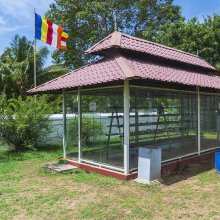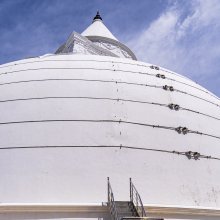Danu, Dānu: 18 definitions
Introduction:
Danu means something in Buddhism, Pali, Hinduism, Sanskrit, Jainism, Prakrit. If you want to know the exact meaning, history, etymology or English translation of this term then check out the descriptions on this page. Add your comment or reference to a book if you want to contribute to this summary article.
Images (photo gallery)
In Hinduism
Purana and Itihasa (epic history)
Source: Wisdom Library: The Matsya-purāṇaDanu (दनु) is the name of a mind-born ‘divine mother’ (mātṛ), created for the purpose of drinking the blood of the Andhaka demons, according to the Matsya-purāṇa 179.8. The Andhaka demons spawned out of every drop of blood spilled from the original Andhakāsura (Andhaka-demon). According to the Matsya-purāṇa 179.35, “Most terrible they (e.g., Danu) all drank the blood of those Andhakas and become exceedingly satiated.”
The Matsyapurāṇa is categorised as a Mahāpurāṇa, and was originally composed of 20,000 metrical verses, dating from the 1st-millennium BCE. The narrator is Matsya, one of the ten major avatars of Viṣṇu.
Source: archive.org: Puranic Encyclopedia1) Danu (दनु).—General information. Danu, the daughter of Dakṣa was married to Kaśyapa Prajāpati. It is mentioned in Mahābhārata that the Dānavas (demons) were born from Danu. Sons. One hundred sons were born to Danu. The following are the important among them.
Vipracitti 3. Namuci
Śibara 4. Pulomā
Asilomā 20. Aśvagrīvan
Keśi 21. Sūkṣma
Durjaya 22. Tuhuṇḍa
Ayaśśiras 23. Ekapād
Aśvaśiras 24. Ekacakra
Aśvaśaṅku 25. Virūpākṣa
Garga 26. Harihara
Amūrdhā 27. Nicandra
Vegavān 28. Nikumbha
Ketumān 29. Kapaṭa
Svarbhānu 30. Śarabha
Aśva 31. Śalabha
Aśvapati 32. Sūrya
Vṛṣaparvan 33. Candra.
Ajaka
(This sun and the moon (Sūrya and Candra) are not the planets).
From the sons named above ten families of Dānavas (asuras) arose. The founders of the families are mentioned below:
Ekākṣa 6. Tapana
Amṛtapa 7. Śara
Pralamba 8. Mahāhanu
Naraka 9. Garviṣṭha
Vātāpi 10. Dīrghajihva
All the dānavas or Asuras belong to one of these ten families. (Mahābhārata Ādi Parva, Chapter 65). (See full article at Story of Danu from the Puranic encyclopaedia by Vettam Mani)
2) Danu (दनु).—A King. Two sons Rambha and Karambha were born to this king. (See Karambha).
Source: Cologne Digital Sanskrit Dictionaries: The Purana Index1a) Danu (दनु).—A son of Kāśyapa and Diti; appointed Purohita.*
- * Brahmāṇḍa-purāṇa IV. 9. 3.
1b) 61 days and nights.*
- * Vāyu-purāṇa 50. 186.
1c) A son of Angirasa.*
- * Vāyu-purāṇa 65. 105.
1d) Known for Māyā.*
- * Vāyu-purāṇa 69. 93.
1e) One of Kaśyapa's wives and a daughter of Dakṣa. Had Dvimūrdhā and sixty other sons;1 Māyāśitā;2 also mother of 100 sons of whom Vipracitti was the chief; mother of the Dānavas; a mother-goddess.3
- 1) Bhāgavata-purāṇa VI. 6. 25; 29-31; Vāyu-purāṇa 66. 55; Viṣṇu-purāṇa I. 5. 124.
- 2) Brahmāṇḍa-purāṇa III. 3. 56; 6. 1-2; 7. 466.
- 3) Matsya-purāṇa 6. 1 and 16; 146. 18; 171. 29 and 58; 179. 19.
Danu (दनु) refers to the name of a Lady mentioned in the Mahābhārata (cf. I.59.12, I.65). Note: The Mahābhārata (mentioning Danu) is a Sanskrit epic poem consisting of 100,000 ślokas (metrical verses) and is over 2000 years old.
Source: Shodhganga: The saurapurana - a critical studyDanu (दनु) refers to one of thirteen of Dakṣa’s sixty daughters given to Kaśyapa in marriage, according to one account of Vaṃśa (‘genealogical description’) of the 10th century Saurapurāṇa: one of the various Upapurāṇas depicting Śaivism.—Accordingly, Dakṣa gets married to Asikni, the daughter of Prajāpati Viraṇa and begot sixty daughters. [He gave thirteen daughters to Kaśyapa]. Kaśyapa’s thirteen wives are Aditi, Diti, Danu, Ariṣṭā, Surasā, Svadhā, Surabhi, Vinatā, Tamrā, Krodhavasā, Irā and Muni.

The Purana (पुराण, purāṇas) refers to Sanskrit literature preserving ancient India’s vast cultural history, including historical legends, religious ceremonies, various arts and sciences. The eighteen mahapuranas total over 400,000 shlokas (metrical couplets) and date to at least several centuries BCE.
Shaktism (Shakta philosophy)
Source: Kamakoti Mandali: The Yoginis of Narasimha VyuhaDanu (दनु) is the name of a Mātṛkā-Śakti created by Mahārudra in order to control the plague of demons created by Andhakāsura.—Accordingly, Andhaka-Asura tried to kidnap Umā (Devī Pārvatī), and was fiercely attacked by Mahārudra who shot arrows at him from his mahāpināka. when the arrows pierced the body of Andhakāsura, drops of blood fell to earth and from those drops, thousands of Andhakas arose. To control this plague of demons, Mahārudra created Mātṛkā-Śaktis [viz., Danu] and ordered them to drink the blood of the demons and drain them dry.
Source: Kamakoti Mandali: Nrisimha matrika-mandalaDanu (दनु) refers to one of the various Mātṛkā-Śaktis created by Rudra in order to destroy the clones that spawned from Andhaka’s body.—Accordingly, [...] Andhakāsura attempted to abduct Girājanandinī (Pārvatī) and thus ensued a fierce battle between Andhakāsura and the great Rudra, the Lord of Umā. Like raktabīja, every drop of blood that fell from the body of Andhaka created another Asura like him and in no time, the entire world was filled with Andhakas. To destroy the growing number of Andhakas, Rudra created innumerable Mātṛkā-Śaktis [viz., Danu]. These Śaktis of immense power at once began to drink every drop of blood that flowed from the body of Andhaka, but they could still not effectively contain the emergence of more and more demons.

Shakta (शाक्त, śākta) or Shaktism (śāktism) represents a tradition of Hinduism where the Goddess (Devi) is revered and worshipped. Shakta literature includes a range of scriptures, including various Agamas and Tantras, although its roots may be traced back to the Vedas.
In Buddhism
Theravada (major branch of Buddhism)
Source: Pali Kanon: Pali Proper NamesMother of the Asuras, who are, therefore, called Danava (Abhidhanappadipika, p.14).
Theravāda is a major branch of Buddhism having the the Pali canon (tipitaka) as their canonical literature, which includes the vinaya-pitaka (monastic rules), the sutta-pitaka (Buddhist sermons) and the abhidhamma-pitaka (philosophy and psychology).
Languages of India and abroad
Sanskrit dictionary
Source: DDSA: The practical Sanskrit-English dictionaryDanu (दनु).—f. Name of one of the daughters of Dakṣa given in marriage to Kaśyapa and mother of the Dānavas. -m. Name of a monster, son of Śrī, cursed by Indra and killed by Rāma and Lakṣmaṇa. He had a headless trunk, and hence called दनुकबन्ध (danukabandha).
Derivable forms: danuḥ (दनुः).
--- OR ---
Dānu (दानु).—a. [dā-nu]
1) Valiant.
2) Conquering, destroying.
-nuḥ 1 A donor.
2) Prosperity.
3) Satisfaction.
4) Air, wind.
5) A demon. -n.
1) A gift.
2) A fluid, drop.
--- OR ---
Dānu (दानु).—&c. See under दा (dā).
See also (synonyms): dāka, dāti, dātṛ, dāna.
Source: Cologne Digital Sanskrit Dictionaries: Shabda-Sagara Sanskrit-English DictionaryDanu (दनु).—f.
(-nuḥ) A daughter of Daksha, wife of Kasyapa, and mother of the demons or Daityas, the Titans of Hindu mythology.
--- OR ---
Dānu (दानु).—m.
(-nuḥ) 1. A donor, a giver. 2. A victor, a conqueror. 3. Prosperity. 4. Air, wind. E. dā to give, Unadi affix nu .
Source: Cologne Digital Sanskrit Dictionaries: Benfey Sanskrit-English DictionaryDanu (दनु).—m. and f. Proper names, [Rāmāyaṇa] 3, 75, 24; 2, 30, 12.
Source: Cologne Digital Sanskrit Dictionaries: Cappeller Sanskrit-English DictionaryDanu (दनु).—[feminine] [Name] of a daughter of Dakṣa, the mother of the Dānavas.
--- OR ---
Dānu (दानु).—1. [masculine] [feminine] a class of demons.
--- OR ---
Dānu (दानु).—2. [feminine] [neuter] any dripping fluid, drop, dew; poss. mant.
Source: Cologne Digital Sanskrit Dictionaries: Monier-Williams Sanskrit-English Dictionary1) Danu (दनु):—f. Name of a daughter of Dakṣa (by Kaśyapa [or danāyū, [Śatapatha-brāhmaṇa i, 6, 3, 9]], mother of the Dānavas), [Mahābhārata i, 2520 ff.; Harivaṃśa; Rāmāyaṇa iii, 20; Viṣṇu-purāṇa] etc., [Varāha-mihira’s Bṛhat-saṃhitā]
2) m. Name of a son of ŚrI (also called Dānava; originally very handsome, but changed into a monster [kabandha] by Indra for having offended him), [Rāmāyaṇa iii f.]
3) Dānu (दानु):—[from dā] 1. dānu mfn. liberal ([Uṇādi-sūtra iii, 32])
4) [v.s. ...] courageous, [cf. Lexicographers, esp. such as amarasiṃha, halāyudha, hemacandra, etc.]
5) [v.s. ...] m. prosperity, contentment, [cf. Lexicographers, esp. such as amarasiṃha, halāyudha, hemacandra, etc.]
6) [v.s. ...] air, wind, [cf. Lexicographers, esp. such as amarasiṃha, halāyudha, hemacandra, etc.]
7) [from dā] 2. dānu mfn. valiant, victor, conqueror, [Horace H. Wilson]
8) [v.s. ...] m. a class of demons (cf. dānava), [Ṛg-veda; f., i, 54, 7; Śatapatha-brāhmaṇa]
9) [v.s. ...] n. a fluid, drop, dew (nas patī m.[dual number] Name of Mitra-Varuṇa or of the Aśvins, [Ṛg-veda viii, 256; 8, 16]; cf. ārdra-, jīra-).
Source: Cologne Digital Sanskrit Dictionaries: Yates Sanskrit-English Dictionary1) Danu (दनु):—(nuḥ) 2. f. A daughter of Daksha, mother of demons.
2) Dānu (दानु):—(nuḥ) 1. m. A donor; a victor; prosperity; wind.
[Sanskrit to German]
Sanskrit, also spelled संस्कृतम् (saṃskṛtam), is an ancient language of India commonly seen as the grandmother of the Indo-European language family (even English!). Closely allied with Prakrit and Pali, Sanskrit is more exhaustive in both grammar and terms and has the most extensive collection of literature in the world, greatly surpassing its sister-languages Greek and Latin.
Prakrit-English dictionary
Source: DDSA: Paia-sadda-mahannavo; a comprehensive Prakrit Hindi dictionaryDaṇu (दणु) in the Prakrit language is related to the Sanskrit word: Danuja.
Daṇu has the following synonyms: Daṇua.
Prakrit is an ancient language closely associated with both Pali and Sanskrit. Jain literature is often composed in this language or sub-dialects, such as the Agamas and their commentaries which are written in Ardhamagadhi and Maharashtri Prakrit. The earliest extant texts can be dated to as early as the 4th century BCE although core portions might be older.
Kannada-English dictionary
Source: Alar: Kannada-English corpusDānu (ದಾನು):—[noun] = ದಾನಿ [dani]2.
Kannada is a Dravidian language (as opposed to the Indo-European language family) mainly spoken in the southwestern region of India.
See also (Relevant definitions)
Starts with (+40): Danopakarana, Danopapatti, Danua, Danuba, Danubian reed, Danucitra, Danuda, Danudvish, Danuj, Danuja, Danujadvish, Danujakula, Danujanasha, Danujari, Danuje, Danujendra, Danukabandha, Danukula, Danumant, Danumat.
Ends with (+16): Addanu, Amdanu, Andanu, Ardradanu, Attaradanu, Baradanu, Brihadanu, Curatanu, Damdanu, Daudanu, Hadanu, Intiratanu, Jiradanu, Jivadanu, Kalu danu, Krandanu, Maidanu, Manitanu, Mekatanu, Nadanu.
Full-text (+127): Danava, Danuja, Sahadanu, Danusunu, Danusambhava, Danupinva, Danuda, Pinva, Ardradanu, Danayus, Saptajit, Kelebua danum, Danumat, Danucitra, Danujendra, Ekacakra, Danujari, Svarnabhanu, Danayu, Danua.
Relevant text
Search found 42 books and stories containing Danu, Dānu, Daṇu; (plurals include: Danus, Dānus, Daṇus). You can also click to the full overview containing English textual excerpts. Below are direct links for the most relevant articles:
Rig Veda (translation and commentary) (by H. H. Wilson)
The Brahmanda Purana (by G.V. Tagare)
Chapter 6 - Glorification of The Race of Danu < [Section 3 - Upodghāta-pāda]
Chapter 1 - Birth of seven sages (saptarṣi): Race of Bhṛgu and Aṅgiras < [Section 3 - Upodghāta-pāda]
Chapter 73 - Description of the glory of Viṣṇu < [Section 3 - Upodghāta-pāda]
Lord Hayagriva in Sanskrit Literature (by Anindita Adhikari)
Some other References of Hayagrīva < [Chapter 3]
Hayagrīva as reflected in the Harivaṃśa < [Chapter 3]
The Agni Purana (by N. Gangadharan)
Chapter 19 - Description of secondary creation: The progeny of Kaśyapa
Chapter 322 - The appeasing rite employing the mantra of the weapon of Paśupati
Chapter 219 - Sacred syllables for coronation (abhiṣeka-manta)
The Padma Purana (by N.A. Deshpande)
Chapter 6 - Diti’s Wailing < [Section 2 - Bhūmi-khaṇḍa (section on the earth)]
Chapter 23 - The Slaying of the Demon Bala < [Section 2 - Bhūmi-khaṇḍa (section on the earth)]
Chapter 9 - Instructions to Diti < [Section 2 - Bhūmi-khaṇḍa (section on the earth)]
Puranic encyclopaedia (by Vettam Mani)
Related products


